Collecting Handkerchiefs is a hobby many of you love!
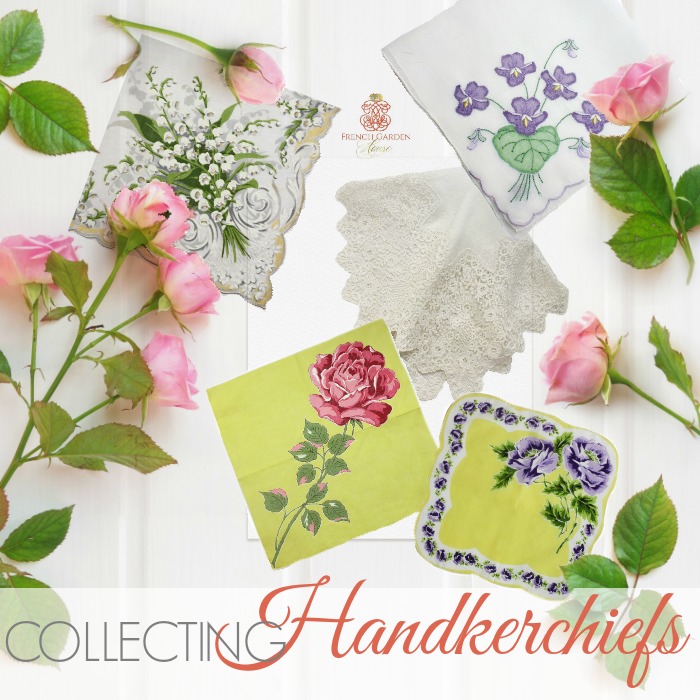
Handkerchiefs have always carried with them
love, hope, heartache and joy.

Many of us have a lingering fondness for a handkerchief
that once belonged to our grandmother or mom.
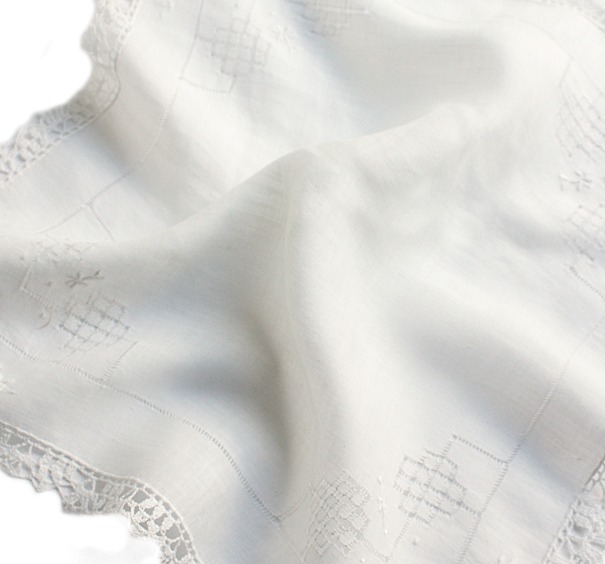
Little squares of cotton or silk that we treasure.
Generations of women have held a handkerchief for the important moments in their lives
and wiped away tears at weddings, funerals, and really funny or sad movies.

Some handkerchiefs have been saved for decades, even centuries.
I personally cherish handkerchiefs left to me by my grandmother and Mom
keepsakes that are so special to me.

Handkerchiefs come in all forms and sizes.
From the elegant, work-of-art made of finest linen edged with glorious hand made lace
to a simple printed square of cotton.
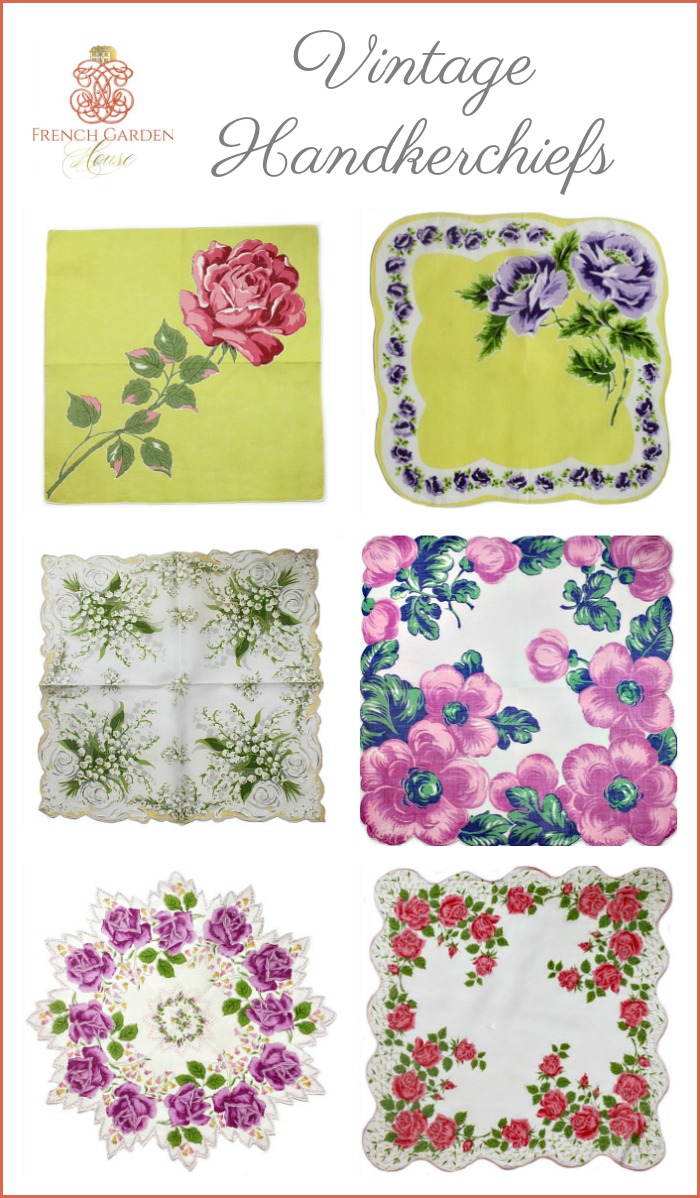
Being from Europe, I’ve never really gotten used to kleenex.
Give me a folded beautiful handkerchief any day!
{I know, but really, it’s eco-sound! And there is the washing machine!}
The origin of handkerchiefs is not glamorous, the name “handkerchief” comes from medieval head scarves called “kerchiefs”,
a cloth that was originally used to wipe away perspiration from one’s head.

HISTORY
The history of handkerchiefs is long, and {believe it or not!} hotly debated by scholars.
In 2,000 B.C. wealthy Egyptians carried the first handkerchiefs made of bleached white linen.
The Kunsthistorisches Museum in Vienna, Austria has a limestone plaque of two sisters, Keti and Senet, holding their handkerchiefs.

Some historians believe handkerchiefs originated in China,
and used to shield a person’s head from the hot sun.
Statues dating to the Chou dynasty {1000 BC} show figures holding decorative pieces of cloth.

Wealthy Roman citizens waved expensive linen handkerchiefs in the air at public games,
and after they wiped the perspiration off their faces,
they threw them in the arena at the beginning of gladiatorial contests.
During the middle ages, knight’s tied a lady’s handkerchief to the back of their helmet
as a good luck talisman.
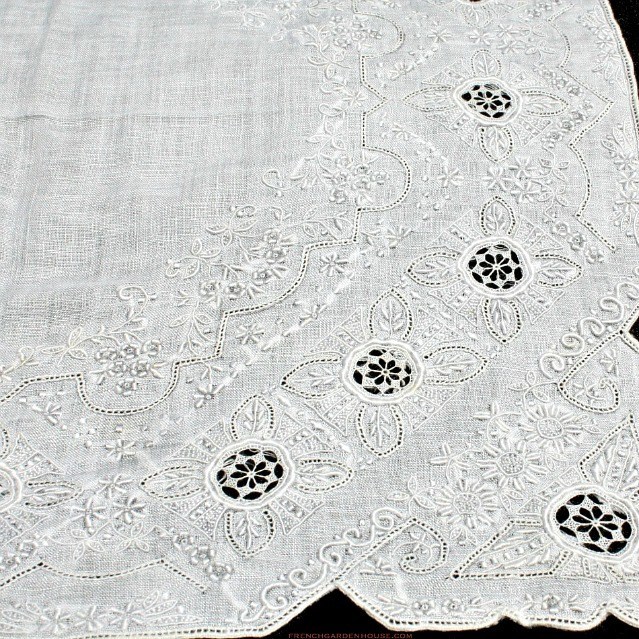
Renaissance portraits show both men and women holding handkerchiefs embroidered
and edged in lace, the more ornate the better.
It’s not surprising the handkerchief became an accessory for flirtations and illicit liaisons in France.

Made of silk or finest batiste, and edged with hand made laces that cost a fortune,
it was another way for aristocrats to distinguish themselves from peasants.
Considered valuable enough to be listed in dowries, and bequeathed in wills.
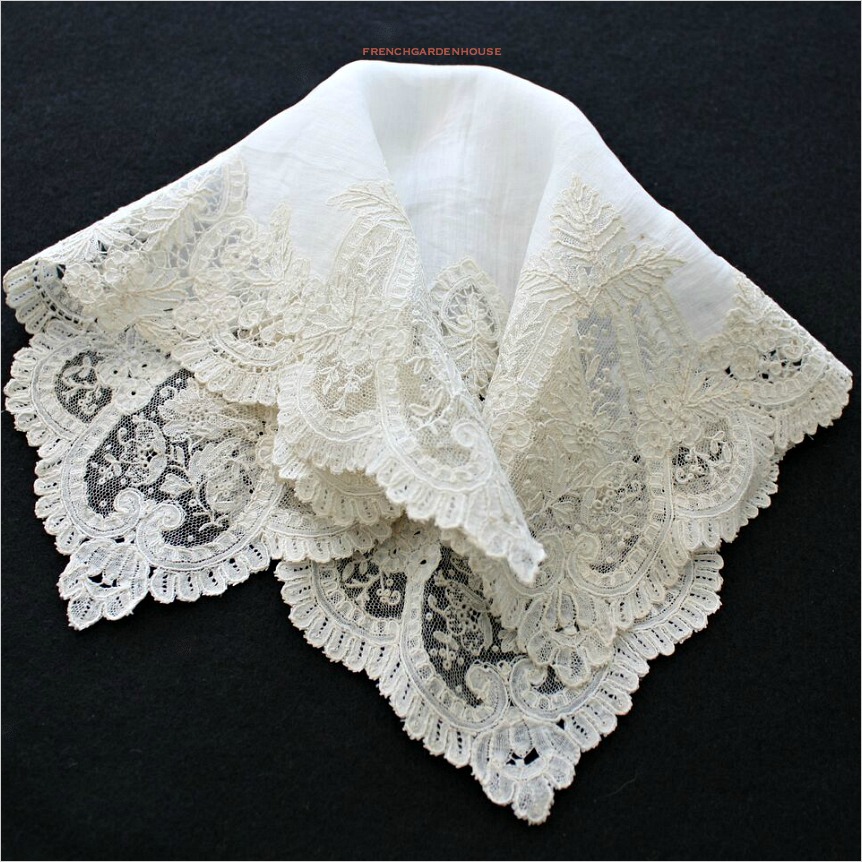
Aristocrats sitting for portraits would request that a handkerchief be included in the picture,
the more embellished the better, to indicate their status and position.

Considered a symbol of wealth, handkerchiefs became larger and larger,
until, in 1785 Louis XVI issued a decree prohibiting anyone from carrying a handkerchief larger than his.
Held in the hand, they were necessary for “the flirt”
Handkerchiefs also demonstrated wealth and social status.

Peeking out from little bags, tucked into sleeves, or draped across an arm,
the lace and embroidered luxuries were meant to be admired.
Royalty owned dozens of handkerchiefs edged in Flanders needle lace, or wildly expensive Venetian laces.
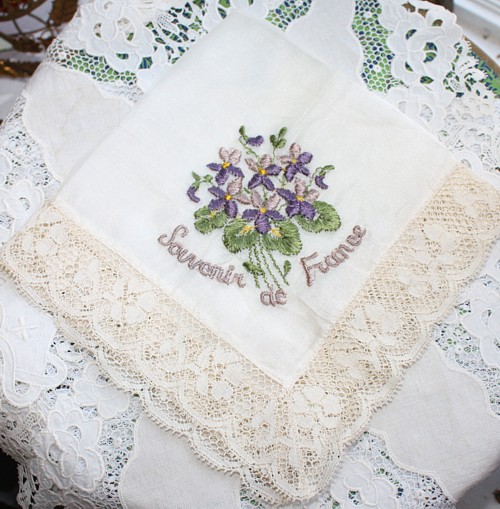
Jumping to the Great Depression, handkerchiefs became “the” accessory for women to change their look,
it was all they could afford. During WWII, women opted for a wardrobe of hankies,
foregoing new hats or blouses for the war effort.
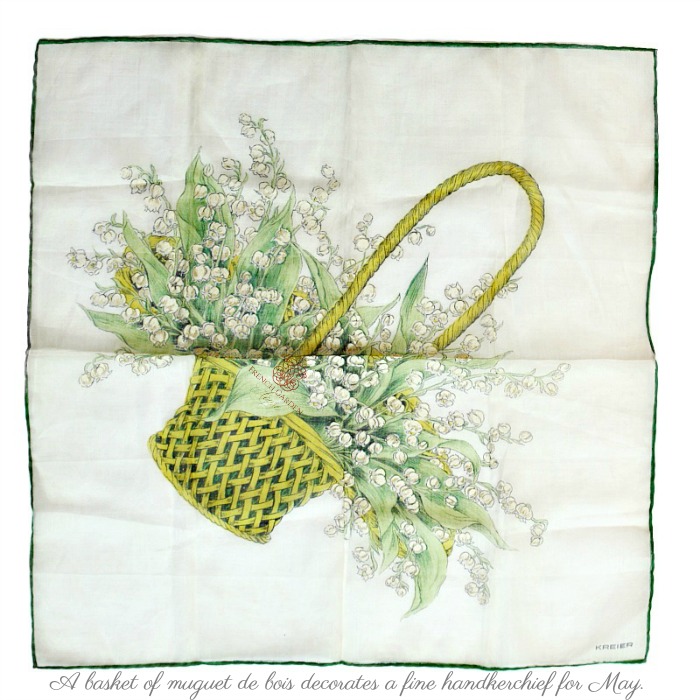
Vogue magazine had an ad featuring a “handkerchief” of the month, a brightly colored printed cotton one.

After the French couture houses got back into full swing after WWII,
designers like Dior and Balmain featured handkerchiefs as the best accessory of the season.
Tied to handbags, popping out of a jacket or blouse pocket, worn as a bracelet on the wrist,
handkerchiefs were back in a big way.

In the 1950’s-1960’s, handkerchiefs flourished.
Big stores like Neiman Marcus and Lord & Taylor hired commercial artists to design
bright, colorful handkerchiefs for their stores.
Hundreds of designs were produced each year.
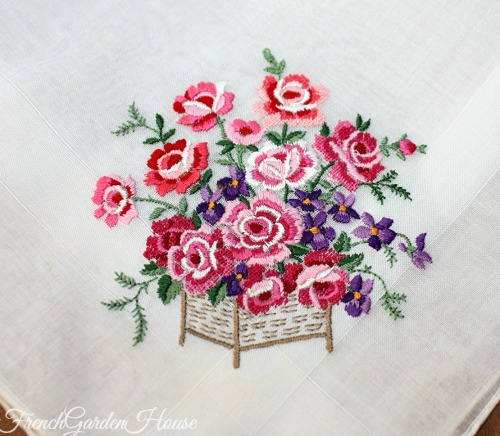
Eventually, most people switched over to the disposable Kleenex,
but handkerchiefs are coming back!

With our “green” mindset, many people are once again reaching for that little square of fabric.
Hermes sells beautiful limited edition silk handkerchiefs that are bought by women as well as men.
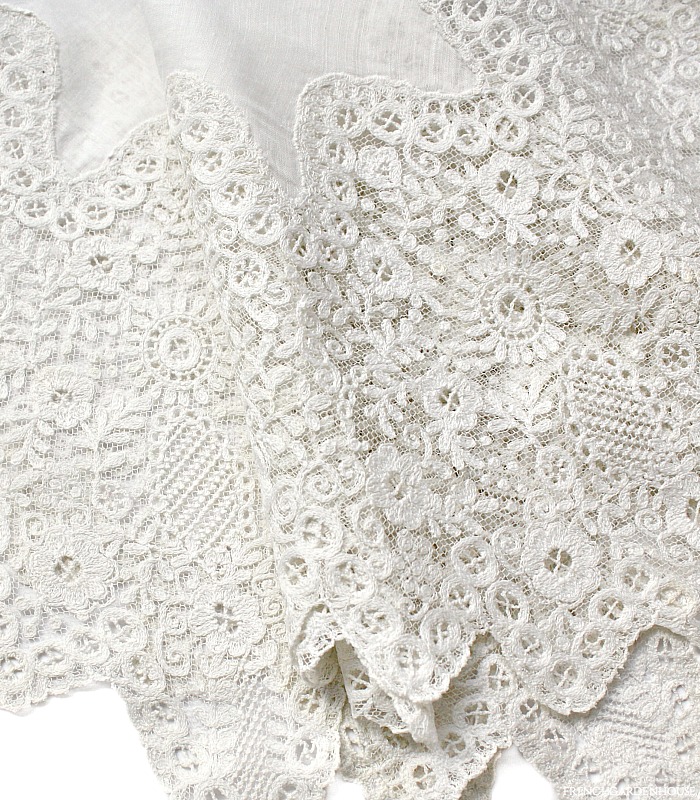
“The tradition of borrowing a bridal hankie may have stemmed from the times
when they were too expensive for a young bride to afford.”
WHAT TO COLLECT:
CONDITION.
As with everything, buy the best quality you can find and afford. Look for fine linen, hand rolled hems, or beautifully scalloped hems, and avoid badly stained or damaged handkerchiefs.
TYPE.
Some collectors only collect the most rare, antique hand embroidered and hand made lace handkerchiefs from the 19th century, or very early 20th century. These sumptuous hand made confections recall the past, when no lady of means would ever be without her luxurious delicate handkerchiefs.
Some collectors only collect the vibrant cotton batiste handkerchiefs from the 1930’s-1940’s. Often printed with themes, such as flowers or states, these are bright, whimsical and fun! Round handkerchiefs of this sort are more rare to find, as they didn’t quite catch on, so they were made for a very limited time.
Handkerchiefs made on linen in Madeira is yet another favored type of handkerchiefs collectors value greatly. Embroidered by hand by the skilled needlewomen of the island of Madeira, they are in a class of quality of their own!
THEME.
Some collectors favor particular themes, like circus animals, signed-by-the-artist handkerchiefs, or advertising. Some seek out geometric prints, florals, or monogrammed handkerchiefs.
WHAT TO PAY.
Handkerchiefs, big or small, simple or sumptuous, can command from a few to more than a thousand dollars for a particularly extensively embroidered luxurious example.
There is a handkerchief for every collector’s budget. Here at FrenchGardenHouse I am most often enchanted by the hand made, luxury pieces of the past from the mid to late 1800’s, although the cheerful bright floral hankies from the 1940’s-1960’s also capture my eye and heart.
Are you a collector and/or user of antique and vintage handkerchiefs?

If you want to romance your Home and Garden with antique and vintage treasures to make you smile each time you come home, visit our shop FrenchGardenHouse.

 Your Cart
Your Cart
Greetings Lidy!
I have many handkerchiefs I’ve “inherited” from my darling Grandma Meme, my mom, my favorite aunt, other aunts, my dad and the most precious, my grandfather that passed before I was born. His is a wedding gift from Meme with his name embroidered on it from Ireland. One of the many items on my “list” of projects is to make 2 small quilts for my granddaughters using the hankies. I’ve seen 2 different styles of quilts using hankies and still deciding which one to attempt. Perhaps one in each style. One style is to lay them flat and attach to each square. The other is to fold them in a sort of fan shape and attach to each square. Your collection is outstanding! Such beautiful details. Thanks for sharing such a sweet item, the handkerchief, and it’s history! Blessings, Edie Marie
Edie Marie, how wonderful!! So many memories you have in handkerchiefs. I love the idea of the quilts, what beauties they will be when you finish them, that’s such a fantastic idea. Wishing you a beautiful week, Edie Marie. xo
Lidy interesting post and history. I didn’t realize there was so much history. Some of it I knew but I not all.
Have a super day
Cindy
Cindy, I love that the things we often take for granted have such a rich and varied “story”, don’t you?
Lidy your collection is beautiful, I have my grandmother’s and mother’s handkerchiefs. Would love some ideas on how to display them. I like the quilt idea, although I am not a seamstress…. Thank you for the post!
Theresa, such a blessing to have your grandmother’s and mother’s handkerchiefs. There are so many beautiful ideas for display, if you don’t sew, I’ve seen gorgeous handkerchiefs framed, either singles, each in their own frame and hung in a grid or line, or a bunch of them together folded in overlapping triangles in a large frame. It looks like art, and is a great way to keep the handkerchiefs clean too!
Lidy,
Thank you for such an informative and interesting article. I use monogrammed hankies to make plaques that spell out a baby’s name to give as gifts to new moms.
Lorrie, what a beautiful and inspiring idea~ I can’t imagine a sweeter gift for a new baby. I absolutely love it!
I especially love the white embroidered ones. I recently started to collect one for each of my four granddaughters for when they get married, as my mother did for me. I’m on the hunt for that just perfect one with each of their initials.=)
What a sweet idea, Sue! It’s absolutely perfect, I think I will copy you!
I loved reading the interesting history of the handkerchief. I remember my elementary principal(in the late 50s) always had a beautiful one tucked into her belt or a lacy one peeking out from a pocket of her dress. I admired them even then. I have many lovely ones from my grandmother and an aunt who were never without them. The most beautiful ones are the lace or tatted ones, but I love the embroidered, the floral ones, and the monogrammed, also. So happy you think there is a resurgence of these beautiful, useful, delicate hankies!
I love those memories, Kathy! My grandmother wore her handkerchief too, in her belt. It didn’t seem like she was dressed if it wasn’t there!
I so enjoyed reading this! I have a drawer full of handkerchiefs, ranging from new ones to eighty years old, and I use them all. Some of the newer ones are my own purchases, but the majority of them belonged to my mother, my maternal grandmother (who was Austrian) and my paternal grandmother (she crocheted the edging on many of them). Some friends don’t understand why I don’t use the “convenience” of a disposable tissue, but I feel it is just so nice to have this bit of beauty in our day.
Oh, I completely understand it, Stevie! We use handkerchiefs here at home, and I too have ones that belonged to Mom and my grandmother, so sweet when I use them! xo
I used to collect handkerchiefs…I started with a sweet laced one which was stored away with the hankie of my childhood…my mom used to wrap my lunch money in it!…then I found a new with label State hankie from my Dad’s home state and it led to to several more purchases, but all with an emotional tie. Your handkerchiefs shown here are exquisite. Thank you as always for the history of the handkerchief. I can just envision the “Knights” riding off to battle with the handkerchiefs tied to their helmets! My dad never left the house without a handkerchief in his pocket…I remember my mom so lovingly ironing them. I love all of the handkerchiefs you have presented here..however, that one from France is my fav! So sweet!! Have a great week Lidy!
Shirley, I love the memory of your Mom ironing handkerchiefs….I still iron ours, because my European husband hates kleenex and needs at least two clean and ironed handkerchiefs a day!
Thank you for this interesting history lesson. I have some handkerchiefs that my mother gave to me which were probably her mothers. I have one draped over a saucer Ina display cabinet in my living room. I must peruse my dresser drawers and see if I have anymore after reading this!
Tammy, I’m so happy you display at least one hankie. It’s such a sweet thing, I think, to have little memories of the women in our families.
Simply beautiful and informational all in the same post. Thank you for the education on the history of hankies, I have a hand made spoon rack that I use to display mine. Feminine and useful what could be better!
Denise
Denise, what a beautiful idea to use the spoon rack! I could see that its the perfect thing to display all your treasures.
I love having you visit.
Wishing you a beautiful week, hopefully with signs of spring!
The something new I have learned today. Thank you for your research and sharing. Years ago I used my mother’s and grandmother’s kerchiefs. You have excited me to do so again.
Marian, I’m excited to hear that! xo
Wow, I learned a lot here today. I love handkerchiefs and never had a clue as to all of their history, so thank you for sharing! Many blessings to you.
Thank you for the interesting history of hankies. I like the ones from 1930-40. I have a few from my mom that are treasured. I am always happy to find hankies at a reasonable price as I always carry a few in my purse, ironed of course.
I love using hankies. So much better than tissues. I have many hankies I received over the years.
Joan
Joan, I love that there are more hankie lovers and users out there than I thought!
when I was a young bride 45 yrs ago I corresponded with my beloved Great Aunt Viola, whom I had actually only ever met once when I was a toddler. We wrote back & forth many years until one day I received a small package from her sister and housemate, Mary, whom I had never met. The note said Viola had passed on to glory but because I was so dear to her she wanted me to have one of Viola’s handkerchiefs as a remembrance. We had very little money in those early years but I promptly took it to be professionally framed and it still hangs in our home today as it has in 5 homes before. I continued corresponding with Great Aunt Mary until her death. Though we never met I loved her, and look forward to meeting her and we are all together one day in heaven.
Oh, Pamela! What a sweet, sweet story, or rather part of your life you have shared here. I love that you cherished the gift so much, and I am sure that you never regretted spending the money to preserve your aunt Viola’s gift.
Another very interesting post, and a great lesson on the origin or hankies.
My rather belated response! I remember when my mom first allowed me to iron, I had to practice on my dad’s big cotton hankies.
I still have a box of Swiss fine cotton embroidered hankies unused, I can’t remember when or who gave them to me.
I remember having a little Swiss hankie with blue embroidery tucked into my wedding dress sleeve!
A few years ago I bought a bundle of beautiful hankies from an estate – which I plan to frame as they are too beautiful to use. I enjoyed this most delightful post! Keep em coming.
Thanks Noreen! I love that you are going to frame some of the handkerchiefs, they will look so beautiful!
When I was a very young girl and our family was in the process of moving to another state, friends of my mother’s held a going-away party for her. All of the women gave mom the gift of one new handkerchief with a small piece of paper pinned to it with their name and the date written on it. Although I was not at the party, I remember fondly all of mom’s beautiful hankies, and how for years she would patiently wrap five quarters in five hankies for her five young daughters to take to church for their Sunday morning offerings.
Many years later, and twenty years after mom passed away, one of my nieces gave me three hankies; one with roses on it for her name, one with violets on it for my birth month, and a man’s plain white hanky. She told me the hankies had come from grandma (my mom), and were part of the collection of hankies mom had given Rose before she died. The man’s hankie had been my dad’s.
I was deeply moved by Rose’s gift and the remembrances of my darling parents they brought (my dad had been gone for a long time at that point, too), and those three hankies started me on a journey of collecting — and saving — vintage handkerchiefs.
Today I have around 2,000 hankies, each treated like a rare treasure to be preserved. Each hankie is lovingly hand washed to remove any stains or discoloration, each is ironed in the shape of a fan with distilled water, each is put in its own acid free, secure top sheet protector, and each page is labeled with where the hankie came from, how much it cost, when it came to the collection, and, if possible, who the original owner was (if I get a hankie from an estate sale I often can get that information!). I have 3-ring binders for holiday hankies, Christmas hankies only, children’s hankies, lovely whites, fancy edges, animals, designers (Tammis Keefe/Jeanne Miller/Kit Ann/etc.!), travel hankies, printed florals, embroidered florals, silk hankies, applique hankies, etc., with approximately 30 3″ 3-ring binders holding my collection.
And the first three hankies in the 3-ring binder of my “best” hankies are the three that came from my mom through my niece.
Thank you, Lidy, for sharing your knowledge of hankies, and allowing us to see the fabulous pieces you have. They are all delightful!
Oh my goodness, what a special collection you must have. I especially LOVE your story behind it, because those memories, they are the most important. Thank you so much for sharing your collection’s story!
I have 4 tubs of beautiful ladies antique hankies and don’t know how to value them to sell. Any ideas
I have just come across this fascinating website. I live in England and have been collecting hankies for over 60 years, starting with souvenir and commemorative ones. I have more than four and a half thousand from all over the world and enjoy writing about them and giving talks (until lockdown!) Over the years I have only come across a dozen other ladies who collect them (two in USA).
I am often asked what will become of the collection in the future as my family are not interested. I wish there was a museum dedicated to them but unfortunately there isn’t.
They depict so many subjects, such as sport, royalty, places, buildings, ships, wars, proverbs, festivals. My knowledge of history and geography has certainly increased and I get a lot of interest from researching unusual finds such as the AOFB. The lipstick, rouge, perfume and snuff hankies have taught me a lot of social history too.
In my cases of children’s hankies are many Disney ones, several with days of the week and I’ve been fortunate to acquire a couple of the books with hankies in such as The Happy Hanky Sewing Circle. Then I have dozens of beautiful lace treasures, many hand-made. It’s a really fascinating collection.
Your collection sounds absolutely wonderful, Brenda!
I have my great aunt’s hanky collection form the 1950s. She basted these hankies onto the pages of three large scrap books. Among my favorites are several Tammis Keefe designs. But she had eclectic tastes; there are flowers, states and other tourist destination designs, holidays and even political themes.
Sometimes hankies and what look like lunch napkins are so similar. What is the difference between and how to tell which is which? Thank you
Denis, while some luncheon napkins can be slightly light, and sometimes sheer, in general they have a heavier weave, whether they are linen or cotton.